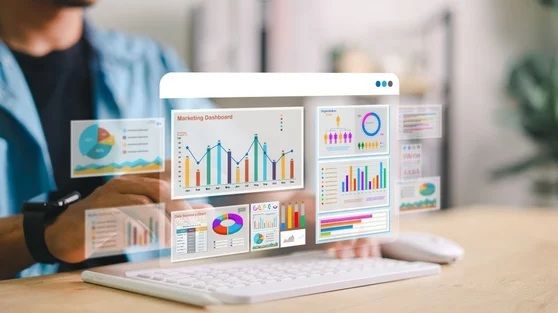Social Media Marketing Metrics That Matter for B2B Companies

Summary: Learn which social media marketing metrics truly matter for B2B companies. Go beyond likes and shares to track lead quality, conversions, and pipeline impact.
Social media marketing isn’t just a B2C playground—it’s a powerful growth engine for B2B companies when measured correctly. And that’s the key word: correctly. While B2C brands often thrive on likes, shares, and viral content, B2B success is rooted in relationships, lead quality, and bottom-line impact. In this guide, we’ll unpack the metrics that truly matter for B2B—going beyond surface-level engagement to reveal real business value.
Beyond Likes & Shares: B2B Social Media Goals
In the B2B world, the effectiveness of social media isn’t measured by superficial metrics like likes, shares, or follower numbers. While these vanity metrics may look good on paper, they don’t reveal the true value of your social media efforts. For B2B brands, success hinges on building relationships, trust, and ultimately, conversions. A post that garners 200 likes but doesn’t result in any leads isn’t contributing to your sales pipeline—it’s simply adding noise.
Unlike B2C, which often sees immediate sales from emotional engagement, B2B is a much longer process, focused on nurturing potential clients through a thoughtful and considered buying journey. Instead of chasing likes, B2B marketers need to focus on more strategic goals, such as building credibility, demonstrating value, and engaging with decision-makers. The key is measuring what truly matters: reach, engagement, and conversion. When combined, these metrics give you a clear picture of whether your social efforts are actually moving the needle in terms of business results.
Reach: Quality Over Quantity
Reach is still essential, but for B2B, it’s more about precision than volume. It’s not just how many people see your post but whether the right people are seeing it. Metrics like impressions and unique views give you an overview of awareness, but the real power comes when you complement these numbers with smart targeting. By focusing on segmentation, paid promotions, and audience-specific messaging, you ensure your content gets in front of the right decision-makers, not just anyone scrolling through their feed.
Engagement: From Passive to Active Interaction
Next, engagement takes visibility to the next level. It’s not about gathering likes but fostering meaningful interactions. In the B2B space, this means initiating conversations, inviting commentary, and encouraging shares that reflect real value. When a potential client engages with your content by commenting or sharing it, you know that your message has hit home. These interactions do more than signal relevance—they amplify your reach, often triggering algorithmic boosts that help you reach even more decision-makers.
Conversion: Turning Engagement into Tangible Business Results
While engagement shows that your content resonates, conversion is where B2B social media efforts pay off. For B2B marketers, this is about tracking how social activity leads to tangible results—whether it’s lead generation, demo requests, or direct sales. Metrics like click-through rate (CTR), conversion rate, and cost per lead are key here. However, these metrics only become actionable when your social media platforms are integrated with your CRM and other tools like Google Analytics, enabling you to trace the journey from social post to signed contract.
Aligning Metrics With Business Goals for Maximum ROI
B2B companies can gain a significant advantage by aligning their social media strategy with broader business objectives. You’re not posting just to fill a feed—you’re working to build your reputation, nurture relationships, and support your sales team. That’s why the real ROI of B2B social media lies not in likes but in metrics like pipeline velocity, deal size, and customer lifetime value, which have a direct impact on your bottom line.
Not every post needs to be a viral sensation. In fact, a thoughtful comment from a key account can be far more valuable than hundreds of anonymous likes. A LinkedIn poll that sparks conversation within a niche industry can drive more value than a meme that generates thousands of likes but no real business results. In B2B, social media success is measured by relevance, resonance, and return—ensuring that every post serves a strategic purpose and brings you closer to your business goals.
Ultimately, social media isn’t just about chasing numbers; it’s about building genuine connections and delivering measurable results. With a more refined approach, your social media efforts can help grow your business, strengthen your brand, and connect you with decision-makers who matter. So, while it’s tempting to chase vanity metrics, focus on what truly drives value: genuine engagement, meaningful interactions, and strategic conversions.
Pipeline Attribution: Connecting Social to Sales
In today’s crowded B2B marketing landscape—where content overload and lengthy sales cycles are the norm—pipeline attribution is more than a reporting tool. It’s the linchpin that connects marketing activity to revenue outcomes. With buyers engaging with an average of 11+ pieces of content across 30 or more touchpoints before ever speaking to sales, surface-level metrics like impressions and clicks no longer cut it. To drive growth and prove marketing’s value, B2B organizations need visibility into how each channel—including social media—contributes to pipeline creation, deal velocity, and revenue.
At its core, attribution assigns a measurable value to every prospect’s interaction with your brand. That might be a first impression from a LinkedIn post, a whitepaper download, or a click on a customer case study shared on social media. These aren’t isolated events—they’re stepping stones in a larger journey. Effective pipeline attribution captures the whole picture, showing how multiple touchpoints collectively influence a buyer’s path to conversion.
Social media is a crucial, though often under-credited, part of that journey. Traditionally seen as an awareness or engagement tool, social media is frequently excluded from ROI discussions because its impact is harder to trace. As mentioned before, vanity metrics—likes, shares, and impressions—may be easy to measure but rarely tell the whole story. What matters is what happens next: Did that post generate interest from a decision-maker? Did it move a lead further down the funnel? Did it contribute to a closed deal?
That’s where multi-touch attribution (MTA) models come in. Rather than crediting only the first or last interaction, MTA assigns proportional value across all relevant touchpoints. A LinkedIn ad might serve as the initial hook, a webinar invite could drive mid-funnel engagement, and a follow-up email could seal the deal. With MTA, you can see how social content supports the entire journey—building awareness, nurturing consideration, and influencing conversion.
For B2B marketers, this level of insight is a game-changer. Attribution enables data-driven decisions about where to allocate budget, what content formats resonate best, and which channels produce the highest-quality leads. For example, if your data shows that organic LinkedIn posts consistently contribute to late-stage pipeline opportunities, you can justify continued investment in that strategy. Attribution also enhances campaign performance: knowing which social messages drive pipeline allows you to double down on what works and refine what doesn’t.
But attribution goes beyond marketing—it aligns teams around shared goals. When marketing and sales operate from the same data, collaboration improves. Sales can see which campaigns generate qualified leads while marketing gains real-time feedback on lead quality and deal progression. This alignment is what turns social from a support function into a strategic growth driver.
Of course, attribution comes with its challenges. Many B2B organisations struggle with siloed systems, fragmented data, and inconsistent KPIs across teams. Without integration between social platforms, CRMs, and analytics tools, tracking leads from engagement to closed-won is nearly impossible. A bloated martech stack can make matters worse, adding complexity without clarity.
A unified tech ecosystem and a clear data strategy are essential to overcome these hurdles. Tools like HubSpot, Salesforce, and Oktopost can help bridge the gap—connecting social activity to CRM data and tying every touchpoint back to pipeline performance. When set up correctly, this infrastructure doesn’t just show where a lead originated—it maps the full customer journey, from first click to final contract.
The true power of pipeline attribution lies in transforming social media into a measurable revenue channel. With attribution in place, social is no longer a “nice to have“—it becomes a proven contributor to business outcomes. Marketers can shift from reporting vanity metrics to driving strategic decisions based on revenue impact.
In a climate where every dollar spent is scrutinized, pipeline attribution is no longer optional. It’s a business imperative. By tying social activity directly to sales outcomes, B2B marketers can demonstrate value, secure budget, and build a repeatable, scalable growth engine. When social media is tracked, integrated, and optimised through attribution, it becomes one of the most powerful levers for revenue generation in the entire marketing mix.
LinkedIn-Specific Analytics that Drive Business Growth
In the B2B world, LinkedIn isn’t just another social platform—it’s the platform. With over 80% of B2B social leads originating on LinkedIn, it’s clear this is where professional conversations happen, decisions are influenced, and buyer journeys often begin. If you’re not actively leveraging LinkedIn-specific analytics, you’re missing a direct line to your most valuable audience: business decision-makers.
Unlike Instagram or TikTok, which revolve around fleeting trends, LinkedIn is built on professional credibility, subject matter expertise, and long-term relationship building. That makes it uniquely positioned to support B2B growth—but only if you go beyond just posting and start paying attention to what your data is telling you.
LinkedIn’s native analytics transform your strategy from guesswork into a data-driven growth engine. These aren’t surface-level metrics designed for engagement theatre. They offer a detailed look at who’s interacting with your content, what’s resonating, and how to turn those insights into measurable business impact.
Start with visitor analytics—a goldmine for understanding the professional profiles of people checking out your company page. You can see industries, job seniorities, company sizes, and functions. This is strategic intel. Are you attracting the right personas? Are C-suite leaders from target accounts taking notice? If not, it might be time to recalibrate your content or messaging.
Follower analytics offer even more context. Are your followers growing steadily—and are they the right people? Knowing where they’re located, what roles they hold, and how they found you can help shape everything from content creation to geographic targeting and account-based marketing campaigns.
Then come the engagement metrics—impressions, reactions, comments, shares, click-throughs. But the real value isn’t in counting impressions—it’s in interpreting what kind of content actually moves people to act. Comments and shares are signs of content that resonates; clicks indicate buying intent. These signals help you fine-tune your messaging, formats, and timing with surgical precision.
Its ability to connect these insights back to broader business goals sets LinkedIn apart. For example, if your content consistently engages procurement or operations professionals, you can align your sales messaging to those job functions. If specific industries are overrepresented in your engagement data, that could guide both outbound efforts and ad targeting.
Competitor analytics further elevate your strategy. With LinkedIn’s benchmarking tools, you can track how your page stacks up against others in your industry. This isn’t about imitation—it’s about spotting content gaps, identifying trends early, and understanding how your share of voice compares within your market.
The true value of LinkedIn analytics emerges when you connect them to revenue-driving actions. Use insights to inform everything from campaign planning to lead qualification. For example, if your highest-converting leads tend to engage with video case studies on LinkedIn, that’s a format worth scaling. Or, if your organic posts consistently attract interest from mid-market firms in healthcare, you’ve just uncovered a priority segment.
In short, LinkedIn analytics provide more than feedback—they provide forward-looking direction. And in B2B marketing, where trust is earned and deals take time, that kind of clarity is invaluable.
Checking analytics occasionally isn’t enough. To drive sustained business growth, B2B marketers must constantly monitor and adapt. LinkedIn gives you the tools to understand your audience, tailor your content, and align with business goals—not just marketing KPIs. When used intentionally, LinkedIn analytics don’t just fuel your content strategy—they fuel your sales pipeline, your brand authority, and your bottom line.
Tools and Technologies for Advanced Social Media Tracking
With so many platforms to manage, a solid monitoring tool is a game-changer. Here are some of the top tools available today:
- PromoRepublic: Excellent for brands with multiple locations. The platform is designed to increase your online presence in search and social media, maintain brand integrity, and manage reviews across all locations and distributors from just one dashboard.
- Sprout Social: Known for its Smart Inbox, Sprout centralizes all your social interactions and allows real-time responses. It also offers advanced social listening and analytics to track campaign success.
- Agorapulse: Excellent for brands looking to focus on key interactions. You can filter out noise, label key conversations, and monitor competitors’ mentions—all from one dashboard.
- RivalIQ: Focuses on competitive analysis. Real-time alerts notify you when competitors make strategic changes or boost content, giving you the upper hand.
- Mention: Tracks over a billion sources and provides alerts for spikes in mentions. Perfect for identifying early signs of a potential crisis—or a viral opportunity.
- Keyhole: Ideal for influencer tracking and hashtag performance. This tool offers solid insights if you’re looking to build partnerships or uncover what’s trending.
- HubSpot: If you’re already using HubSpot’s CRM, their social monitoring features seamlessly integrate with sales data, giving you full-funnel visibility from social interaction to conversion.
- Brandwatch: A powerhouse for brands needing in-depth analytics and sentiment tracking. Its AI-powered alerts and custom dashboards make it ideal for enterprise-level monitoring.
- Meltwater: Offers a 360-degree view by monitoring not just social media but also blogs, podcasts, and news mentions. Its AI visual recognition tool adds another layer of insight by analyzing shared images and videos.
Tips for Successful Social Media Monitoring
Follow these tips for successful social media monitoring:
- Set Clear Goals: Know what you’re trying to measure—brand sentiment, customer service efficiency, or competitor performance.
- Use Boolean Operators: Advanced search features help filter results to only the most relevant mentions and conversations.
- Don’t Just Monitor—Engage: Monitoring is active. Always follow up on important mentions, complaints, or shout-outs.
- Track the Right Metrics: Measure engagement volume, response time, sentiment, and share of voice regularly.
- Centralise Your Data: Use tools that bring multiple platforms into one dashboard to avoid missing key interactions.
In B2B marketing, success on social media isn’t about being seen by everyone—it’s about being seen by the right people and guiding them through the sales journey. By shifting your focus from vanity metrics to performance-driven indicators like lead quality, pipeline attribution, and conversion impact, your social media strategy becomes a measurable asset—not just a digital presence.
Ready to turn your social media into a revenue-generating powerhouse? Let’s talk. Contact us today to build a data-backed social strategy that drives results where it counts.
About the Author
Rick spent 20 years in the insurance industry in finance, primarily developing reporting platforms for B & C stakeholders. His ability to speak to consumers of data (managers and analysts) and translate their needs to programmers led him to start his own digital marketing agency in 2004 to develop data driven solutions for business owners.
The Best Digital Marketing Insight and Advice
We are committed to protecting your privacy. For more info, please review our Privacy and Cookie Policies. You may unsubscribe at any time.
Don’t stop the learning now!


